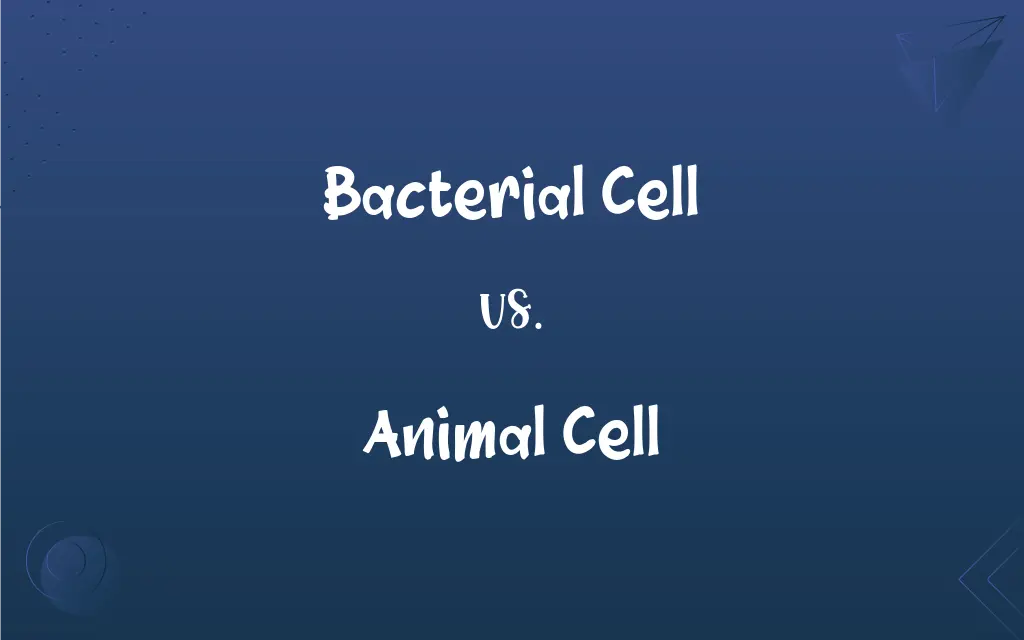Bacterial Cell vs. Animal Cell: What's the Difference?
Edited by Janet White || By Harlon Moss || Updated on October 18, 2023
Bacterial cells are prokaryotic, lacking a nucleus and membrane-bound organelles, while animal cells are eukaryotic, possessing a nucleus and specialized structures.

Key Differences
Bacterial cells belong to the group of prokaryotic organisms, which means they lack a true nucleus. Animal cells, on the other hand, are eukaryotic, having a well-defined nucleus containing DNA surrounded by a nuclear envelope.
Structurally, bacterial cells differ significantly from animal cells. The genetic material of a bacterial cell is found in a nucleoid, a region without a membrane. In contrast, an animal cell's DNA resides within the nucleus, enveloped by a nuclear membrane, providing an additional layer of protection.
Another striking difference between bacterial and animal cells lies in the presence of organelles. Animal cells boast a variety of membrane-bound organelles, such as the endoplasmic reticulum, Golgi apparatus, and mitochondria. Bacterial cells, devoid of these membrane-bound organelles, rely on different methods for cellular functions.
Cell wall composition is another distinguishing factor. Bacterial cells have a rigid cell wall primarily composed of peptidoglycan, which provides them with structural support. Animal cells, conversely, lack a cell wall, possessing only a flexible plasma membrane surrounding their outer layer.
While both bacterial and animal cells play pivotal roles in the natural world, their structural and functional differences underscore the vast diversity of life. These distinctions allow them to thrive and operate efficiently within their respective environments.
ADVERTISEMENT
Comparison Chart
Nucleus
Lacks a true nucleus
Contains a well-defined nucleus
Organelles
No membrane-bound organelles
Has membrane-bound organelles
Cell Wall
Made of peptidoglycan
Lacks a cell wall
Genetic Material
Found in the nucleoid
Enclosed within the nucleus
Size
Generally smaller
Typically larger
ADVERTISEMENT
Bacterial Cell and Animal Cell Definitions
Bacterial Cell
A microscopic, single-celled organism lacking a true nucleus.
Diseases can be caused when a harmful bacterial cell invades a host.
Animal Cell
A eukaryotic cell that makes up animal tissues.
The animal cell has various organelles to perform specialized tasks.
Bacterial Cell
The basic structural and functional unit of bacteria.
The bacterial cell multiplied rapidly under favorable conditions.
Animal Cell
A cellular unit with a nucleus and membrane-bound structures.
The nucleus of an animal cell contains the genetic information.
Bacterial Cell
The smallest entity characterizing the bacterial species.
Scientists studied the bacterial cell to understand its resistance mechanism.
Animal Cell
The foundational biological component of all animals.
Observing the animal cell under a microscope reveals its intricate details.
Bacterial Cell
A prokaryotic cell distinct from plant and animal cells.
Antibiotics target specific components of the bacterial cell to halt infections.
Animal Cell
A cell distinct from plant and bacterial cells.
The absence of a cell wall is a distinguishing feature of an animal cell.
Bacterial Cell
An organism with a simple cellular structure.
The bacterial cell's simplicity allows for rapid reproduction.
Animal Cell
A complex cell characterized by the presence of various organelles.
Mitochondria in the animal cell produce the energy required for its functions.
FAQs
Can bacterial cells be multicellular?
Typically, bacterial cells are unicellular, but some can form complex structures.
Why is the cell wall of bacterial cells a target for antibiotics?
The unique composition of the bacterial cell wall makes it a prime target as its disruption can halt bacterial growth.
Do bacterial cells have mitochondria?
No, bacterial cells lack mitochondria.
Where is the DNA located in an animal cell?
In an animal cell, DNA is located within the nucleus.
Can animal cells photosynthesize?
No, animal cells cannot photosynthesize as they lack chloroplasts.
How do bacterial cells obtain energy?
Bacterial cells obtain energy through various metabolic pathways, including fermentation and respiration.
What is the function of the nucleoid in a bacterial cell?
The nucleoid houses the bacterial cell's genetic material.
What gives bacterial cells their shape?
The cell wall and cytoskeleton components give bacterial cells their shape.
What is the main structural difference between a bacterial cell and an animal cell?
A bacterial cell is prokaryotic and lacks a true nucleus, while an animal cell is eukaryotic with a defined nucleus.
What protects the bacterial cell from its environment?
The bacterial cell is protected by its cell wall and outer membrane.
Do all animal cells look the same?
No, animal cells can vary in shape and function based on the tissue or organ they belong to.
Do animal cells have chloroplasts?
No, animal cells lack chloroplasts, which are found in plant cells.
How do substances enter and exit an animal cell?
Substances enter and exit an animal cell primarily through the plasma membrane via processes like diffusion and active transport.
Are all bacterial cells harmful?
No, many bacterial cells are beneficial and play essential roles in processes like digestion.
What role do organelles play in an animal cell?
Organelles in an animal cell carry out specialized functions vital for the cell's survival and operation.
What provides structural support to an animal cell since it lacks a cell wall?
The cytoskeleton provides structural support to the animal cell.
Which organelles are found in animal cells but not in bacterial cells?
Organelles like the nucleus, mitochondria, endoplasmic reticulum, and Golgi apparatus are found in animal cells but not in bacterial cells.
How do animal cells communicate with each other?
Animal cells communicate through various means, including chemical signals and direct contact.
Do bacterial cells have a cytoskeleton?
Yes, bacterial cells have a rudimentary cytoskeleton that aids in cell division and maintaining cell shape.
How do bacterial cells reproduce?
Bacterial cells reproduce primarily through binary fission.
About Author
Written by
Harlon MossHarlon is a seasoned quality moderator and accomplished content writer for Difference Wiki. An alumnus of the prestigious University of California, he earned his degree in Computer Science. Leveraging his academic background, Harlon brings a meticulous and informed perspective to his work, ensuring content accuracy and excellence.
Edited by
Janet WhiteJanet White has been an esteemed writer and blogger for Difference Wiki. Holding a Master's degree in Science and Medical Journalism from the prestigious Boston University, she has consistently demonstrated her expertise and passion for her field. When she's not immersed in her work, Janet relishes her time exercising, delving into a good book, and cherishing moments with friends and family.































































